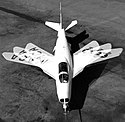Bell X-5
| Bell X-5 | |
|---|---|
 | |
| Typ | Experimentalflugzeug |
| Entwurfsland | |
| Hersteller | Bell Aircraft Corporation |
| Erstflug | 20. Juni 1951[1] |
| Produktionszeit | Wurde nie in Serie produziert |
| Stückzahl | 2 |
Die Bell X-5 war ein einsitziges strahlgetriebenes Experimentalflugzeug, das in den USA entwickelt wurde. Es diente zur Erforschung der Veränderung der Flügelpfeilung während des Fluges.[2][3]
Entwicklung
Ausgangspunkt der Entwicklung war das gegen Ende des Zweiten Weltkriegs erbeutete deutsche Strahlflugzeug Messerschmitt P.1101, an die das Grundkonzept von Rumpf und Leitwerk angelehnt war. Allerdings konnte bei der P.1101 die Flügelpfeilung nur am Boden verändert werden, während dies bei der X-5 auch im Flug möglich war.[4] Die X-5 war damit das erste echte Schwenkflügelflugzeug der Welt. Um die Lage des Schwerpunkts zu erhalten, waren die Tragflächen der X-5 außerdem in Längsrichtung verschiebbar.[5]
Die X-5 wurde von einem einzelnen Allison-Strahltriebwerk J35-A-17 angetrieben. Triebwerkseinlauf und -auslass befanden sich unter dem Rumpf.[6]
Von der X-5 wurden zwei Exemplare gebaut. Deren Erstflüge fanden am 20. Juni bzw. 10. Dezember 1951 statt. Am 14. Oktober 1953 stürzte die zweite der beiden Maschinen ab. Der Pilot Raymond Popson kam dabei ums Leben. 1955 wurde das Testprogramm eingestellt. Die verbliebene Maschine steht heute im Nationalmuseum der US Air Force auf der Wright-Patterson Air Force Base in der Nähe von Dayton, Ohio.
Die aus dem Forschungsprojekt X-5 gewonnenen Erkenntnisse führten später zu Flugzeugen wie der General Dynamics F-111, der Grumman F-14 oder der Rockwell B-1. Auch andere Staaten stellten später Schwenkflügler in Dienst. Dazu zählen der europäische Panavia Tornado sowie die sowjetischen Muster MiG-23, Su-17, Su-24, Tu-22M oder Tu-160.[4]
Technische Daten
| Kenngröße | Daten[7] |
|---|---|
| Besatzung | 1 |
| Länge | 10,16 m |
| Flügelpfeilung | zwischen 20° und 60° verstellbar |
| Spannweite | zwischen 6,32 m und 10,21 m (je nach Pfeilung) |
| Höhe | 3,66 m |
| Flügelfläche | 16,26 m² gesamt |
| Leermasse | 2.880 kg |
| max. Startmasse | 4.479 kg |
| Antrieb | ein Allison J35-A-17 |
| Standschub | 21,8 kN |
| Höchstgeschwindigkeit | 1.134 km/h |
| Gipfelhöhe | 12.800 m |
| Reichweite | 1.200 km |
Siehe auch
Weblinks
Einzelnachweise
- ↑ Dennis R. Jenkins, Tony Landis, Jay Miller: American X-Vehicles. An Inventory – X-1 to X-50 – Centennial of Flight Edition. In: Monographs in Aerospace History. Band 31. National Aeronautics and Space Administration, Office of External Relations, Washington DC 2003, S. 11 (nasa.gov [PDF]).
- ↑ Fritz Dubs: Hochgeschwindigkeits-Aerodynamik – Vorgänge und Probleme in kompressibler Strömung (= Flugtechnische Reihe, Band 2). 2. Auflage. Springer, Basel 1975, ISBN 3-0348-5924-4, S. 64 (eingeschränkte Vorschau in der Google-Buchsuche): „Im weiteren besteht als Radikalmittel zur Eliminierung der erwähnten unangenehmen Eigenschaften [der Abreißbeginn der Strömung im Flügelaußenteil] die Möglichkeit, im Langsamflug durch Verstellen der Flügel die Flügelpfeilung zu beseitigen. Entsprechende, erfolgreich durchgeführte Versuche wurden erstmals mit dem Versuchsflugzeug Bell X-5 vorgenommen.“
- ↑ United States National Aeronautics and Space Administration (Hrsg.): NASA's Contributions to Aeronautics – Flight Environment, Operations, Flight Testing, and Research (= NASA SP, Band 570). National Aeronautics and Space Administration, 2010, ISBN 978-0-16-084636-6, S. 264 (eingeschränkte Vorschau in der Google-Buchsuche): „Spurred on by postwar interests in the variable-wing-sweep concept as a means to optimize mission performance at both low and high speeds, the NACA at Langley initiated a broad research program to identify the potential benefits and problems associated with the concept. The disappointing experiences of the Bell X-5 research aircraft, which used a single wing pivot to achieve variable sweep in the early 1950s, had clearly identified the unacceptable weight penalties associated with the concept of translating the wing along the fuselage centerline to maintain satisfactory levels of longitudinal stability while the wing sweep angle was varied from forward to aft sweep. After the X-5 experience, military interest in variable sweep quickly diminished while aerodynamicists at Langley continued to explore alternate concepts that might permit variations in wing sweep without moving the wing pivot location and without serious degradation in longitudinal stability and control.“
- ↑ a b Stephen Corda: Introduction to Aerospace Engineering with a Flight Test Perspective (= Aerospace Series). John Wiley & Sons, 2017, ISBN 978-1-118-95336-5, S. 414–415 (eingeschränkte Vorschau in der Google-Buchsuche): „The first variable sweep aircraft, where the wing sweep could be changed in flight, was the Bell X-5 research aircraft […]. The design was similar to the German Messerschmitt P.1011 prototype fighter aircraft, which had variable sweep wings, but the sweep could only be changed manually on the ground. The Messerschmitt P.1011 never flew and was captured by the USA after World War II. The German variable-sweep aircraft was shipped to the Bell factory in the United States, where it was studied by the Bell engineers prior to the design of the X-5. However, unlike the P.1011, the Bell X-5 could change its wing sweep in flight to three sweep positions of 20, 40, or 60°. The first flight of the Bell X-5 was on 20 June 1951. Two X-5 aircraft were built, completing test flights up to Mach 0.9. Valuable aerodynamic, stability, and control data were obtained for variable sweep aircraft at transonic speeds. Unfortunately, the X-5 had poor spin characteristics and one aircraft was lost due to an unrecoverable spin, with the wings in the 60° sweep position. […] The X-5 successfully demonstrated the technological feasibility and aerodynamic benefits of a variable sweep aircraft. Variable sweep wings have been used on a variety of production aircraft, including the General Dynamics F-111 Aardvark, Grumman F-14 Tomcat, Rockwell B-1 Lancer, Panavia Tornado, and Mikoyan MiG-23 Flogger.“
- ↑ Dart-Shaped Plane Sweeps Its Wings Back in Flight. In: Popular Science. Band 159, Nr. 2. Bonnier Corporation, August 1051, ISSN 0161-7370, S. 84 (eingeschränkte Vorschau in der Google-Buchsuche): „Obviously designed for high speeds, the X-5 has a gas-turbine engine instead of the rocket engine that powered the X-1. And, unlike the X-1, it doesn't have to be launched by a mother plane. It can take off from the ground under its own power. The heart of the X-5 is an electric mechanism, highly secret, that moves the wings forward and backward. Bell had to solve a problem there-as the wings were moved, the plane's center of gravity shifted, and that had to be compensated for. Preliminary flight tests of the new plane are being conducted at Edwards Air Force Base in California by Jean L. "Skip" Ziegler, Bell's chief of flight research.“
- ↑ Experimental Airplane Changes Angle Of Wing Sweepback While In Flight. In: United States. Air Force, Air Matériel Command, Documents Division (Hrsg.): Technical Data Digest. Band 16, Nr. 7–12. Air Documents Division, Intelligence T-2, Air Matériel Command, 1951, S. 5 (eingeschränkte Vorschau in der Google-Buchsuche): „Viewed in profile, the X-S has a "Fying guppy" configuration which results from mounting its Allison J-35-A-17 turbojet engine under the cockpit rather than behind the pilot. […] The X-5 is 33 ft 4 in. long and 12 ft from ground to fin tip. Wing span is 32 ft 9 in. and weight is approximately 10,000 Ib. […] Two dive brakes are located in the sides of the fuselage forward of the cockpit. They are metal "doors" which can be opened hydraulically until they are at nearly right angles to the fuselage. Protruding, they provide rapid deceleration. The axial-flow turbojet engine develops a 4900-1b thrust. […]“
- ↑ M. Meyer: Bell X-5. In: Fliegerrevue Nr. 3/2022, PPV Medien, Bergkirchen, ISSN 0941-889X, S. 61.
Auf dieser Seite verwendete Medien
US Flag with 48 stars. In use for 47 years from July 4, 1912, to July 3, 1959.

